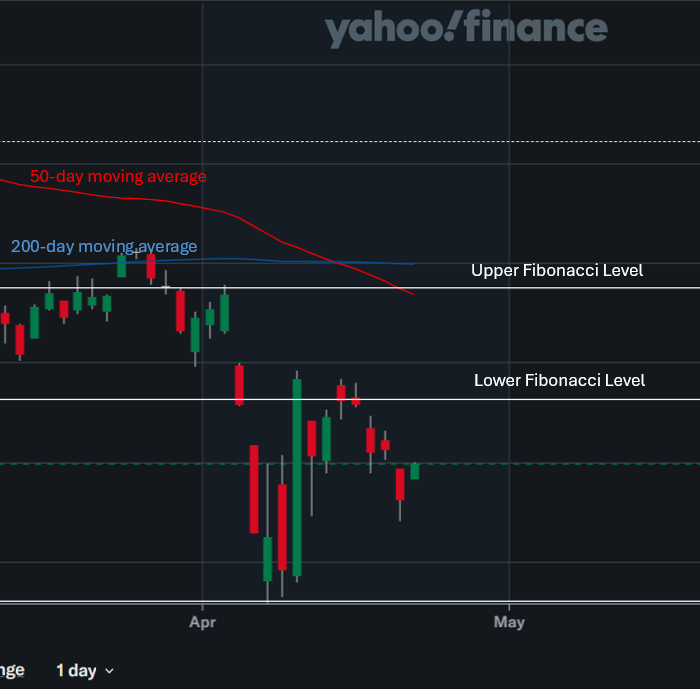- The Wealth Expedition
- Posts
- What Can Fibonacci Numbers Tell Us?
What Can Fibonacci Numbers Tell Us?
Fibonacci numbers are found everywhere in nature, from the microcosm to the macrocosm. Here's how some investors might use them in the present market.

Good morning,
Today we’re going to take a look at some technical analysis! We're still in the midst of a market correction that could easily turn either way, but we can celebrate a very good week for the S&P 500 at 4.59% from start to finish. Which way it turns from here depends largely on future government action and whether the Federal Reserve cuts interest rates in its early May meeting. Let’s take a look at why I think the next three weeks are crucial to determining future market direction.
Today’s newsletter features:
What Happened This Week
Ancient Greek Wisdom for a Balanced Life
Recession vs Bear Market
Launch Your Personal Wealth Expedition!
And be sure to check out this week’s YouTube episode on budgeting here!
Learn AI in 5 minutes a day
What’s the secret to staying ahead of the curve in the world of AI? Information. Luckily, you can join 1,000,000+ early adopters reading The Rundown AI — the free newsletter that makes you smarter on AI with just a 5-minute read per day.

NEWS
What Happened This Week
On February 19, the S&P 500 closed at $6,144.15.
On April 7, it opened at $4,953.79.
The difference between these two points is $1,190.36, a total of a 19.37% drop. Just a hair away from a bear market.
Here’s why this matters.
Technical analysis (using historical charts to spot patterns and predict the future) is not a scientific or greatly reliable way of timing the market by itself. But because so many investors believe in patterns, it can generate a sort of self-fulfilling prophecy that’s somewhat reliable in predicting very short-term moves.
In a vacuum, don’t use technical analysis for market timing. But if it’s part of your overall analysis, which includes more fundamental data, it can be a useful element of the strategy,
So here’s what I see approaching.
Fibonacci numbers are found everywhere in nature, from spiral galaxies to the ratio of the human body, from pinecones to sunflowers, and even the number of petals on flowers.
What is a Fibonacci number?
It’s a progression of numbers determined by the sum of the two numbers that came before it. Like this:
0, 1, 1, 2, 3, 5, 8, 13, 21, 34, 55, 89, 144, 233…and so on.
See it?
0+1=1, and 1+1=2, and 2+1=3…
Notice that dividing the previous number by the following number becomes closer and closer to equaling 0.618.
1 / 2 = 0.5
13 / 21 = 0.619
144 / 233 = 0.618
So 0.618 is considered the “Golden Ratio,” and some investors believe so strongly in this that they use it as a floor or a ceiling.
Back to the recent market drop.
If we take the total $1,190.36 that the S&P 500 dropped, and multiply that by 0.618, we get $735.64.
Now we can do two things: subtract this number from the high point and add it to the low point.
1) Subtract $6,144.15 - $735.64 = $5,408.51
2) Add $4,953.79 + $735.64 = $5,689.43
These are two places where the markets will very likely encounter at least some degree of resistance before crossing above or below.
The problem is that the 50-day moving average recently intersected with the upper level of $5,689.43. This makes the level particularly difficult to breach in the next few days. Right now, fortunately, the market price is above the lower level of $5,408.51.
So it's in between the levels.
I’m enjoying the beaches of Florida right now (and not at my computer), so my chart below is from Tuesday instead of Friday before the price point crossed above the lower Fibonacci level, but it still illustrates the point:
The 50-day moving average has been declining by an average of 15 points per day, which if that continues, could even cross with the lower $5,408.51 level after about 3 weeks of trading (given similar market environments going forward).
If we don’t get good upward movement in the next three weeks, I think the chances of a more extensive downturn tick higher.
But the good news is that markets experienced a solidly positive week, with the S&P 500 climbing 4.59%. And the Fed still has room to cut interest rates several times over the coming months and even years. They have the chance to do something during the May 6-7 meeting.
If they cut rates, even slightly, they could help shift the momentum before it becomes too engrained to save from a bear market. But the Fed has to be careful not to raise expectations of inflation at the same time. It’s a tricky situation for them without an obvious solution, but in my opinion, I think a 25 bps cut in May would be prudent.


“Nothing in excess.”
-Inscription upon Apollo’s Temple in Delphi, Greece
PARADIGM SHIFT
Ancient Greek Wisdom for a Balanced Life
One thing I encountered quite often as a financial advisor was an extraordinary fear of loss.
Understandably, risk aversion tends to increase as we get older. Going back to work at 70 or 80 years old isn’t exactly what everyone longs to do. But that's why we manage risk the long-term way through allocation rather than knee-jerk reactions and guessing games.
Ironically, the greatest risk we face may not actually be market losses, but a life spent avoiding risk so thoroughly that we miss the chance to do something meaningful.
Regardless of age or career stage, here’s something that never goes away: a desire for purpose and significance.
Many of us, if given the choice, would trade some degree of comfort and ease for a life filled with meaning, purpose and personal growth — in pursuit of achieving something bigger than ourselves.
I was reminded of the timelessness of this inclination when reading The Culturalist.
In Homer’s Odyssey, he describes Odysseus’s sojourn on Calypso’s island paradise, filled with every ease and pleasure and comfort known to mankind. In the words of The Culturalist, “There’s no work to be done, no sickness, and no fear of death — just comfort, peace, and pleasure.”
When we’re in the midst of busy life, it’s so easy to get caught up in an idealistic vision of what we think would make us happy: comfort, peace and pleasure…all of the time.
But to our amazement, Odysseus eventually rejects such a life. He leaves Calypso’s island to once again become a mortal, participating in human events that involve difficulty, effort, risk and loss.
I think something similar also happens to those of us who either retire early or take a long sabbatical (like a gap year) where we do everything we ever wanted to do with our time.
Just like Odysseus realized paradise without purpose was a prison, many retirees discover that freedom without direction feels strangely empty.
As we fulfill one ideal, we suddenly see another ideal with fresh perspective. And maybe it’s an ideal we could have achieved far sooner if we’d properly identified it.
So many people are working hard to retire as soon as possible. Once they retire, they will need to find a new direction that achieves purpose and fulfillment. But we don’t have to wait until retirement to strike this balance.
True wealth isn’t just financial. It’s the harmony of four currencies: purpose, time, flexibility and money. And all of these can be achieved far sooner than retirement with the proper knowledge, direction and objectives.

FINANCIAL TOOL
Recession vs Bear Market
We’ve been hearing the word “recession” tossed around a lot lately.
For the stock market, what matters is whether a bear market is on the horizon.
A recession is roughly defined by two consecutive quarters of negative economic growth (measured by GDP). The National Bureau of Economic Research has the final word on this, as they also consider other factors such as unemployment, personal income, etc.
A bear market is defined by at least a 20% drop in the stock market from its most recent high point.
More often than not, a bear market has happened in close proximity to a recession, sometimes starting before and sometimes after the onset of the recession.
Depending on the timeline observed, historically about 75% of bear markets have happened in connection with a recession around the same time.
What can we learn from this? If a bear market occurs, there’s a decently high chance that we’re already in a recession or are quickly approaching one.
But if we’re going to save our investments from the worst effects of a bear market, we can’t afford to wait for the 20% drop to happen!
Because once we learn we’re in a recession, it’s usually far too late to avoid the bear market. Collectively, investors tend to predict recessions with stock market values before they’re ever recognized to be in effect.
It’s not necessary to be 100% correct when predicting a bear market, however.
What’s important is to recognize the conditions in which they usually form, and then reduce risk more or less according to what red flags are arising.
So long as you can keep upside potential strong (by holding onto equities), you can place hedges with protective put options to keep downside from being catastrophic to your plan.
In times when red flags are prominent, a put option with a strike price closer to the current price (think 5% below) might be a smart choice. When there are more green flags than red flags, keeping the strike price further (think 10 to 15% below the current price) can be a cheaper move that creates less of a drag on the portfolio.
Without listing all the red flags of a bear market, here’s one worth noting.
Too much unity in the political environment.
When the US President and the Congress feature the same party in power, if the party is unified, this can create a scenario where legislation happens very quickly. This rapid and sometimes dramatic change to law can cause businesses and consumers to pause or slow their otherwise normal spending and investing activities.
The downside potential this creates isn’t necessarily because the changes being made are good or bad.
It’s more due to the impact of Prospect Theory:
1.) The opposing party feels fear, anger and distrust. And negative emotion, the pain of perceived loss, is felt 2.5x more than the equivalent feeling of gain. This can drive the market in a negative direction.
2.) Changing rules often create winners and losers. For the same reasons, the feeling of loss overpowers the feeling of gain and drives markets downward.
This isn’t a hard and fast rule, but it is a reason why bear markets and corrections so often happen during the first half of a US President’s term (regardless of political party in power). In mid-term elections, the President’s party usually loses seats in the Congress, creating gridlock that slows the rate of change for the second half of the Presidency.
We’re certainly in a situation right now where things are changing very quickly and dramatically. And the situation is such that uncertainty could just as easily increase as it could decrease from here.
The scope of what is trying to be accomplished, however, is likely something that will take years to fully accomplish. And uncertainty for that amount of time could easily lead to a bear market, and even (though less likely) a recession, in the interim.

HERE’S HOW I CAN HELP
Launch Your Personal Wealth Expedition!
Ready to take control of your financial destiny?
Here are the two foundational courses which will set you on course to radically transform the way you live and work.

Budget, Build, Bridge: The Roadmap to Financial Independence
This course will lead you step-by-step toward developing your escape plan into a life of comprehensive wealth: time, flexibility, purpose and money.
Each lesson builds upon the last, covering these main topics:
Master high-impact budgeting techniques to create a surplus today.
Develop a plan to become debt-free in record time.
Raise your salary this year.
Use tax strategy to fast-track your goals.
Bridge your way to entrepreneurship.

Advanced Investing for Financial Freedom
Whether you're new to investing or a seasoned expert, this course is designed to make anyone a master of what I believe to be the most important investing concepts.
Here's what you'll learn in this course.
The foundational concepts for analyzing the risk and performance of mutual funds and ETFs.
How your goals affect the allocation of your investment portfolio.
How to fine tune the risk factors in your portfolio to weight the odds of success in your favor.
How to identify stages of the market cycle and build your portfolio around it.
How, when and why to hedge against downside risk.
How this all ties together as one comprehensive wealth expedition from ground zero to financial independence.
With investing, it often takes an understanding of just a handful of concepts to make all the difference in your ability to make tremendous wealth over time.
My goal with this course is to offer you what I see as the most important concepts to successful investing, setting you on course to achieve your dream life well in advance of retirement age using simple but powerful habits of finance.

How did you like today's newsletter?I'm always looking for ways to offer greater value to fellow explorers. Your feedback helps set the direction for future content! |

I’d love to hear from you. Let me know what you’d like to see in upcoming newsletters, articles, or a digital course at Contact Us - The Wealth Expedition.
